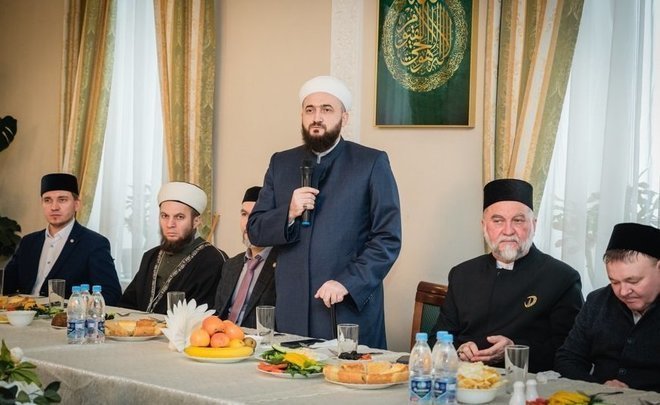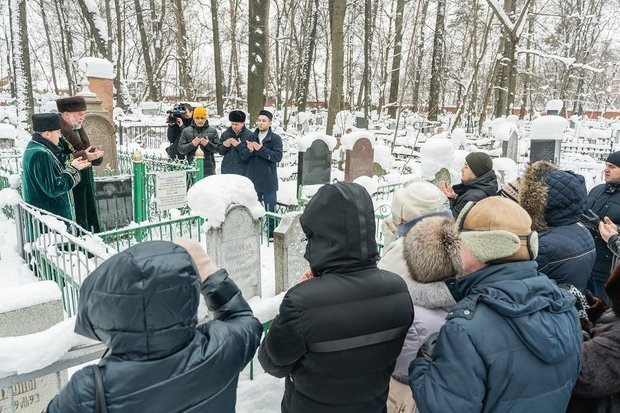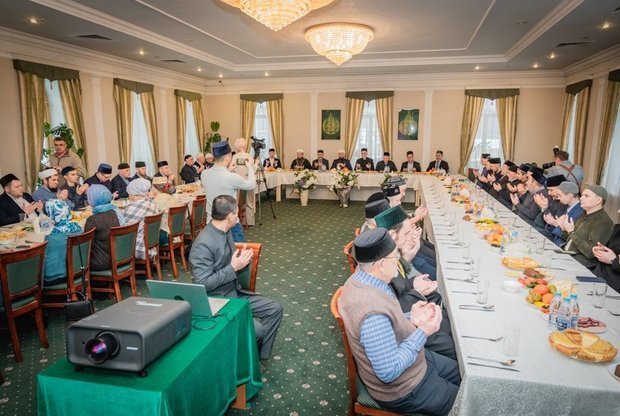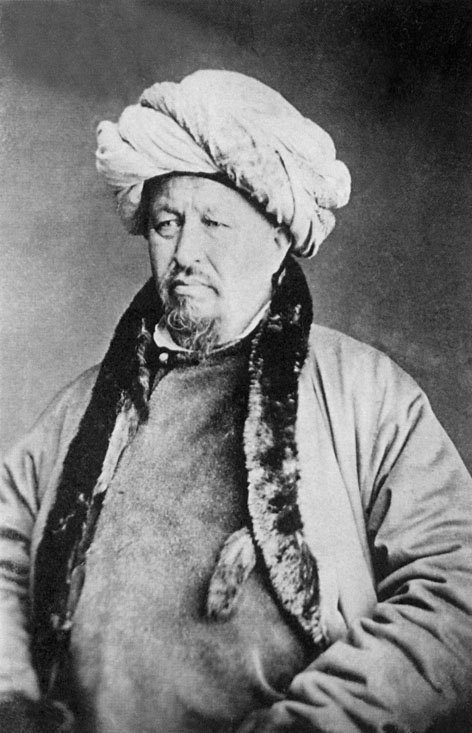Marjani’s Birthday: cemetery and lunch lecture hall
The Muslim Spiritual Board of the Republic of Tatarstan reported that it is planned to release a previously unpublished six-volume book of the great theologian in Turkey

The birthday of Imam and theologian Shigabutdin Marjani was creatively celebrated on 16 January in Kazan. Starting with a traditional visit to the New Tatar cemetery, khazrats and scientists moved to the Marjani Mosque, where lectures were combined with lunch. There, the mufti of the Republic of Tatarstan, Kamil khazrat Samigullin, said that next year the scientific world will probably be able to read Marjani's six-volume handwritten creation “Loyalty to Predecessors and Greetings to Descendants”.
Is it possible to celebrate birthdays?
Reading verses in the cemetery is a Tatar tradition. That day, imams and scientists also performed dua at the graves of Gabdulla Tukai, Alfiya Afzalova, and Ilkham Shakirov. After that, the guests, led by Mufti of Tatarstan Kamil khazrat Samigullin, moved to the Marjani Mosque, to its banquet hall, where the round table discussion “Shigabutdin Marjani and his legacy” was planned.
But it was more like “ash”: the tables were lined with the letter “П”, and the white screen was decorated with artificial flowers. The first to speak was the imam-khatim of the mosque, Mansur khazrat Jalyaletdin, who recalled that there are still disputes about celebrating birthdays, but the welcoming mufti has long proved that it is possible to do so.
“Mansur khazrat 'planted' this topic for us," Samigullin began his speech. “We all know that when a child is born, we rejoice, we share joy with our relatives. So, joy over the birth of a child is not forbidden. Another question is, is it possible to rejoice every year? Our Prophet Muhammad (may he be in peace) rejoiced every week. Because he fasted every Monday. He explained the reasons like this: it's my birthday. He didn't say any other reasons.”
In short, you can rejoice on your birthday, the mufti concluded, if — with no frills. After that, he remembered one of the stories about Marjani from his contemporaries:
“When he passed by a store and saw the sign in Russian, he fumed — why don't you write in Tatar if the state doesn't forbid?" the khazrat said. By the way, journalists immediately had a question whether it was necessary to duplicate all the inscriptions in the mosque in two languages, in particular, the green sign “exit” from where the food was taken out.

The six handwritten volumes are studied by the Turks
At the same time, not all of the heritage is published by the Khuzur publishing house under the MSB RT, Samigullin pointed out, in particular, Marjani's essay, in which he prohibits interethnic marriages: “This is a separate topic, so we decided not to publish it.”
But the muftiate plans to take on a more voluminous project. We are talking about the handwritten six-volume book “Wafiyyat al-aslyaf wa tahiyyat al-ahlyaf” (“Loyalty to Predecessors and Greetings to Descendants”). The introduction to it, “Muqaddimah," was published by the Russian Islamic Institute at the end of 2022.
“It has two variants. It was said that one variant is in the KFU, the other is in Tashkent. We asked in Tashkent, then we were told that it was in Tajikistan, in St. Petersburg. We didn't find it. But now the Turks have found it, they are preparing an edition, Alla Birsa, in six months they are releasing it to the press. And we will read it, too, inshallah.”

“I was somewhat confused by the format of our round table”
After that, it was the turn of lectures from the staff of the Institute of History.
“I was somewhat confused by the format of our round table discussion, I expected something else a little bit and it seems to me that khazrat said a lot of what I had prepared," began Dinara Mardanova, the acting head of the Department of the History of Religions and Public Thought. At that moment, plates of soup began to be served, so that the story of Marjani's life was accompanied by a slight clink of spoons.
It should be noted that in addition to scientists and khazrats, several actors of the Kamala theatre were at the meeting. In short, they were mostly men. They were eating and talking quite audibly. And the women were giving lectures.
January 16 marked the 206th anniversary of Marjani's birth. This happened in the village of Yabynchi (now the Atninsky district). Shigabutdin spent his childhood in the village of Tashkent (now Arsky district), where he received his first religious education, and then studied in Bukhara and Samarkand.
Mardanova said that at the age of 20, Marjani, on his way to Central Asia, met in Troitsk with a muezzin, with whom he argued about the ideas of Gabdennasyr Kursavi, which the young scientist opposed (and later developed his ideas in his writings).
Upon returning, the young Marjani became the imam-mudarris of the 1st Kazan Mosque, which now bears his name. A few years later, he begins to quarrel with Ibrahim Yunusov, who was a trustee of the mosque. Colleagues write denunciations against him. Nevertheless, in 1871 he opened his madrasah, whose building still stands on the corner of Kayuma Nasiri and Zaini Sultan streets. He could even become a mufti, but this was prevented by pressure from above.

It is quite difficult to explain the importance of Marjani's work without delving into theological terminology. Tourists, for example, are told how he became the first mullah to take a picture, showing with his authority and knowledge that this is permissible. First of all, he was a very purposeful and brave man. In the book “Mustafadel-akhbar fi akhvali Kazan ve Bolgar” (“Collection of information about the affairs of Kazan and Bulgar”), he actively promoted the ethnonym “Tatars”. He criticised sophistry and advocated openness and progress, for the study of natural sciences and foreign languages. When he went on Hajj, he was greeted in every city as a prominent figure of the Muslim world.
The lecture was continued by Lyalya Murtazina, a leading researcher at the Centre for the History and Theory of National Education. She reminded about Marjani's wide range of contacts. He was constantly in contact with the scientists such as Alexander Kazem-Bek, Vasily Radlov, Olga Lebedeva. Through Khusain Faizkhanov, he communicated with figures from St. Petersburg. Marjani, by the way, was a member of the Society of Archaeology, History, and Ethnography at the Kazan University:
“His pedagogical concept is to teach students to think independently. This was a new perspective in the educational system. In the future, these ideas will find a place in the works of Jadidists," Murtazina pointed out, adding that the “problem—based learning” that appeared in the 1970s was also based on teaching independent thinking.
Senior researcher Elmira Salakhova turned to the metric books of the 19th century. In particular, she pointed out questions about the date of Marjani's birth, which is hinted at by a collection of documents, memoirs, and articles about the theologian published in 1915, that is, 3 years before the centenary.
We should add that the issue of the Marjani museum in his house on Kayuma Nasiri Street remains semi-open — the prefecture of the “Old Town” clearly indicated that it should not be expected to open this year.